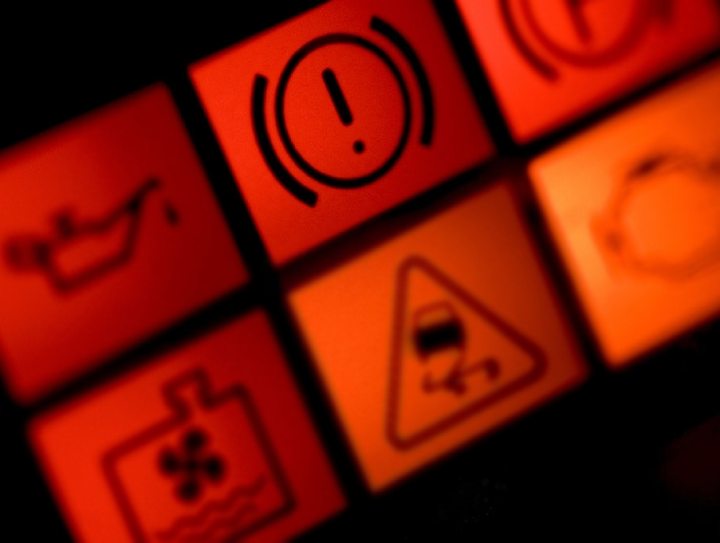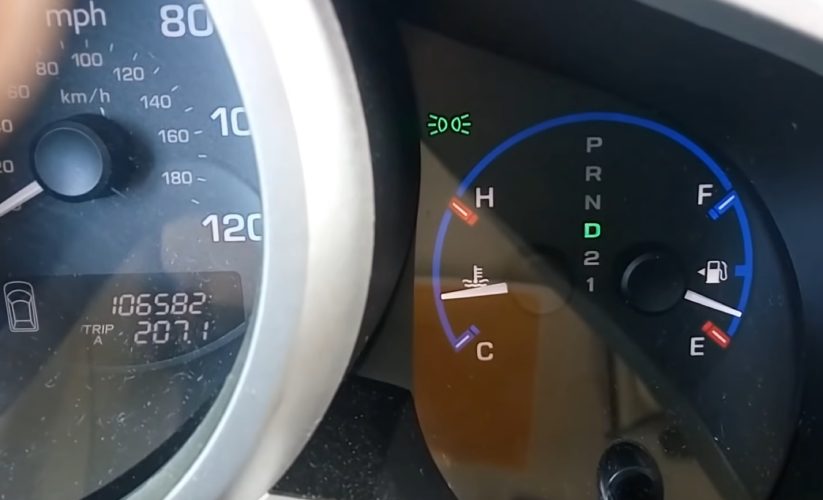If your car loses power and the traction control indicator light comes on while driving, this might indicate possible issues with your wheel speed sensors, steering angle sensors, or a faulty traction control module.

What Does the Traction Control System Do?
The traction control system controls the amount of slip allowed between the tires and the road in a vehicle. The control on the slip assists the driver in accelerating or cornering the car with a tamed or organized stance.
The traction Control System monitors the speed of all four tires on a vehicle. If the speed of any tire abruptly increases as compared to the rest. It indicates that the particular tire is undergoing a slip.
The TCM (Traction Control Module) monitors each tire’s speed and takes input from a couple of other sensors on the vehicle to actuate the brakes on the slipping tire for fractions of seconds, stopping it from slipping. It also limits the engine RPM until the slipping stops.
The traction control light on the dashboard is also illuminated whenever the car slips to inform the driver.
Some sports vehicles allow the driver to set the amount of slip he anticipates by selecting the degree of traction control from “Comfort” and “Sports” settings. It limits the amount of slip on the tires to ensure the vehicle is well within the driver’s control at all times.
Why Is My Traction Control Light ON?
Traction control light can illuminate on the dash whenever the TCS (Traction Control System) is engaging or when the traction control system cannot perform correctly due to a failed sensor or part.
If the traction control light on your vehicle is ON continuously even when the car is idling, then the TCS light indicates an error in the system that needs diagnosis and repair. We have mentioned the probable causes and failures that cause the TCS light to turn ON in detail below.
1. Faulty Wheel Speed Sensors
Wheel speed sensors or ABS sensors are responsible for reporting the exact speed of each wheel to the Traction Control Module in real-time.
These sensors are mostly mounted on the wheel hub and get showered with dirt, mud, and water all the time. Over time, exposure to the environment can lead to corrosion and loose connections, which can result in wrong readings from the sensor to the TCM.
When receiving unusual values from a failed sensor, the computer turns the tractions light on and saves the error code to be diagnosed.
You can scan the error codes on the vehicle to find out exactly which speed sensor has failed. Replacing wheel speed sensors is not more than a 15 min job. These sensors cost around 15-30USD each on online parts stores.
You can start by lifting the car on a jack or turning the wheel in the opposite direction to get good access to the wheel hub. Locate the wheel speed sensors and dismount the sensor by loosening the bolt holding it in place.
Disconnect the wiring from the old faulty sensor and attach the wiring with the new one. Repeat the steps in reverse, and the error code along with the TCS light should go away.
2. Faulty Steering Angle Sensor
The Traction Control System also takes the steering angle sensor input to calculate and limit the amount of slip on the tires.
The second most probable cause for a traction light ON is the failure of this sensor.
The steering angle sensor is mounted in the steering, sitting under the airbag assembly along with the clock spring. The sensor can overtime lose calibration or fail due to bumps on the road.
A faulty steering angle sensor can be detected by reading the error codes on the vehicle. In some cases, the steering angle sensor is working fine but is only out of alignment. In this case, you need to recalibrate the steering angle sensor with a proper diagnostic and programming tool.
Steering angle sensors also cost around 70-100USD but are somewhat difficult to replace. So, you should probably head over to your trusty mechanic to get the sensor replaced without much hassle.
After installing a new steering angle sensor, you must calibrate it according to your steering as well.
3. Faulty Traction Control Module
The Traction Control Module or TCM receives all the inputs from various sensors on the vehicle to detect slip on any of the wheels. The TCS light can also stay ON if the vehicle’s TCM is unresponsive or is fried due to any electrical anomaly (Over or Undervoltage).
Traction control modules usually do not die or lose their memory that often. It is highly unlikely for you to damage your TCM unless your vehicle has a poor battery or a faulty alternator voltage regulator.
You would need to get the TCM reprogrammed or replaced after proper diagnosis of the module. TCM reprogramming requires professional programming equipment and expertise, so it is better to get it reprogrammed or replaced by a professional car mechanic.
TCM reprogramming typically sets you back around 400 – 800 USD. Suppose you require complete replacement of the module. In that case, the module can cost you from 400 to 1250 USD, depending on your vehicle, along with 150-200 USD in labor, depending on how easy it is to work on the car.
The traction control module shares several sensors with the ABS (Anti-Locking Braking System) and ESC (Electronic Stability Control) modules.
It is expected that the failure of a particular sensor, such as the wheel speed sensor or the steering angle sensor, can cause all three signs to light up on your dashboard. Which can make the situation seem a lot worse than it is.
The exact cause of the TCS light on your dashboard can accurately be diagnosed with any proper diagnostic tool easily available at most well-known workshops. You would either require recalibration or replacement of the sensor or the module itself.
What should you do if your car Loses Power and Traction Control Light Comes On?
If you are facing this problem regularly, then you should have your car checked by a professional mechanic as soon as possible. Ideally, you should seek a mobile mechanic that can diagnose and fix the car at your place. All you might need is your Traction Control Module to be reprogrammed!
Every since I was a little boy, I can remember spending the afternoons in my dad’s repair shop. I got my first car at 16 and it was the best feeling ever!
I have contributed to various automotive publications but decided it’s finally time to settle for something constant.









